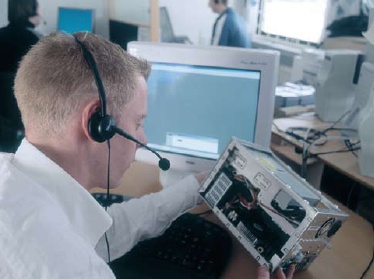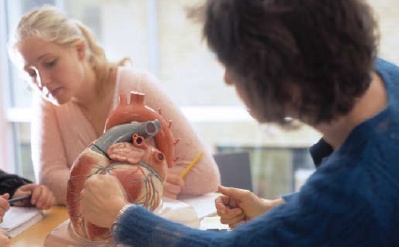
|

An involving systemThe Danish VET system is characterised by a high degree of stakeholder involvement. Not only the social partners, but also colleges, enterprises, teachers and trainees are involved in a continuous dialogue about, and development of, the Danish VET system. The cooperation between the Ministry of Education and the social partners is very well developed, and the vocational colleges and the enterprises also share responsibility for the training of each individual trainee – all of which ensures that the qualifications obtained are well-known and generally recognised in the labour market. The involvement of stakeholders creates a system based on consensus and a system in which responsibilities are shared within clearly defined boundaries. 
The Ministry of EducationThe Minister of Education is responsible for the general education policies and for ensuring that the VET programmes are consistent with these policies. In regard to VET, the Ministry lays down the overall objectives for the VET programmes and provides the framework within which the stakeholders, i.e. the social partners, the vocational colleges and the enterprises, are able to adapt the curricula and methodologies to the needs of the labour market and of the trainees. The Ministry is responsible for ensuring that the VET programmes have the breadth required for a youth education programme and for the allocation of resources. The Ministry is furthermore responsible for approving new VET qualifications on the basis of recommendations from the Advisory Council for Initial Vocational Education and Training (Rådet for de Grundlæggende Erhvervsrettede Uddannelser – REU), and for approving the colleges that are to provide the basic and main courses in VET. It is also the Ministry which lays down the overall rules for VET – in cooperation with the REU – and draws up the regulations on the individual VET programmes – in cooperation with trade committees (please see The social partners, page 17). The regulations are supplemented with guidelines drawn up by the trade committees and issued by the Ministry (please see Facts about the national legislative framework, page 26). Finally, the Ministry is responsible for inspection and quality assurance, which are issues gaining in importance. The introduction of new steering principles, such as framework governance and decentralisation in 1991 (please see Reform 1989, page 41), which granted providers greater autonomy with regards to adapting VET provision to local needs and demands, accentuated the need to implement national quality approaches which, on the one hand, supported decentralisation, and on the other hand, ensured central control with the quality of VET provision. The social partnersOne of the main characteristics of the system is the active participation of the social partners at all levels of the system. This guarantees that the content of the individual VET programme meets the demands of the labour market and that the qualifications are recognised by business and industry. The social partners are represented in a number of councils and committees acting at local, sectorial and national levels. The Advisory Council for Initial Vocational Education and TrainingThe Advisory Council for Initial Vocational Education and Training (Rådet for de Grundlæggende Erhvervsrettede Uddannelser – REU) comprises 25 members from the social partners, the school leader and teacher associations as well as a number of members appointed by the Ministry of Education. The chairperson is appointed by the Minister of Education. The aim of the REU is to advise the Ministry of Education on all matters concerning the VET system. It is responsible for monitoring labour market trends and on this basis recommending the establishment of new VET qualifications, the adaptation of existing ones or discontinuation. It is also responsible for monitoring existing programmes and, based on its findings, for making recommendations for better coordination between programmes or the merging of programmes. The REU concentrates on general national issues concerning VET provision in Denmark. The trade committeesThe national trade committees (de faglige udvalg) provide advice on specific VET qualifications relevant to their sector and on the content, structure, duration and evaluation of programmes and courses. Employers and employees are equally represented in the trade committees. Each committee is responsible for one or more VET qualifications. In 2008, there are approximately 120 trade committees. One of the main objectives of involving the social partners is to ensure the relevance and quality of VET programmes in relation to the labour market. The trade committees are responsible for the continuous adaptation and development of the VET programmes. The committees monitor the skills development in the labour market and, on that basis, recommend changes to existing programmes. They may also recommend the establishment of new VET programmes or the discontinuation of out-dated VET programmes. The role of the social partners is to ensure that VET matches the needs and demands of enterprises and of the labour market at both national and local levels. Another important aspect of the trade committees’ scope of work is the approval of training places. The trade committees are responsible for approving and inspecting enterprises that want to take on trainees on the basis of defined criteria. In order to be approved, an enterprise must have a certain level of technology and a variety of tasks to be performed that will ensure the trainee a full range of activities and tasks corresponding to the qualification requirements of a skilled worker. Finally, the trade committees are responsible for the journeyman’s test and for issuing certificates to trainees (technical training). The trade committees set up their own secretariats with their own budgets, funded by the social partners themselves. The secretariats are responsible for the day-to-day administration and service the social partners by drawing up analyses, preparing case work, initiating courses for external examiners, etc. The local training committeesThe local training committees (de lokale uddannelsesudvalg) assist the vocational colleges in the local planning of the programmes. They provide advice on all matters concerning training and are responsible for strengthening the contact between colleges and the local labour market. The local training committees consist of members representing the organisations represented on the national trade committees. They are appointed by the trade committee upon recommendation from the local branches/affiliates of the organisations. The local training committees also include representatives from the college, the teachers and the trainees. The local training committee acts as advisor to the college in all matters concerning the VET programmes within their jurisdiction and, furthermore, promotes cooperation between the college and the local labour market. In the VET programmes, there has traditionally been a division of labour between the Ministry of Education and the social partners: the Ministry is responsible for the school-based part of the training and the social partners for the work-based part. ProvidersThe VET programmes are provided by vocational colleges and enterprises. CollegesThere are five types of colleges:
The colleges provide not only VET, but also short-term higher education (korte videregående uddannelser – KVU) and adult vocational training. Furthermore, the commercial and technical colleges provide vocationally-oriented technical and commercial upper secondary education programmes (htx/hhx) that qualify for both employment and admission to higher education. In 2008, there are 115 vocational colleges nationwide providing VET programmes. The colleges are approved by the Ministry of Education to provide specific basic and main programmes. Approval is given on the basis of two considerations: the aim of building sustainable VET environments and the aim of ensuring the geographical dispersion of VET. The colleges are independent public institutions with their own board of governors. The majority of the members must reflect the working areas of the college. Employers’ and employees’ organisations must be represented in equal numbers and must represent the geographical area or the sectorial areas of the college’s VET provision. In addition, the teachers and trainees of the college are represented on the board. The colleges have relative autonomy vis-à-vis the budgeting, organisational and pedagogical strategies and the local planning of the VET programmes. The colleges are responsible for the local planning of the VET programmes in cooperation with the local training committees. The content of the training is laid down in a local education plan, corresponding to the general regulations and guidelines for the specific VET qualification. The overall elements of the local education plan are laid down in the Act on Vocational Education and Training, which stipulates, for example, that the local education plan must include a description of the pedagogical, didactical and methodological principles for the training, including a description of how the trainees are involved in the planning and implementation of teaching. The local education plan must also include descriptions of teacher qualifications, technical equipment, cooperation between the college, the trainees and the enterprises, the personal education plan and logbook, etc. EnterprisesPractical training takes part at an enterprise which has been approved by the relevant trade committee. The enterprises can be approved to be responsible for the whole training period or for part of the training period. In order to be approved, an enterprise must have a certain level of technology and must be able to offer the trainee a variety of tasks, which ensures him/ her qualifications corresponding to those of a skilled worker in the chosen occupation. The companies are represented at national level, via their employers’ organisations, at local level in the local training committees and in the boards of directors of the local vocational colleges. In both VET and CVET, the enterprises are able to “colour” the local education plans/CVET courses so that they meet the specific needs and demands of the local or regional labour market. TraineesThe trainees also play an institutionalised role in the Danish VET system. Pursuant to the Act on Vocational Education and Training4, the trainees are able to influence both their own training and the general school environment. This is done by involving the trainees in the planning of the teaching and training. In the day-to-day training activities, the teachers may involve trainees in laying down overall themes for a specific subject, or by letting them choose between different assignments (this is also part of the overall differentiation of teaching). Via student councils and the trainees’ representation on the board of governors, the trainees have the possibility of voicing their opinions. The trainees have a decisive influence not only on their own training but also on the colleges’ provision of education and training by means of their educational choices and the description of their learning pathway in their personal education plans. Furthermore, the Ministry of Education initiates surveys among the trainees, for example in connection with major reforms, whereby the trainees are able to provide feedback on national VET policies. 
Footnotes4) Act on Vocational Education and Training LBK 561 of 06/06/2007.
|
||
|
To the top of the page |